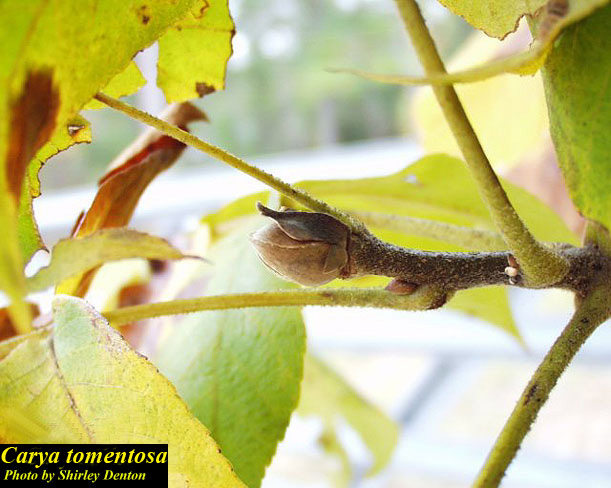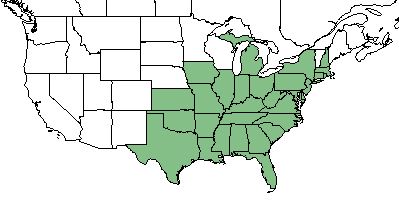Difference between revisions of "Carya tomentosa"
(→Description) |
(→Description) |
||
| Line 25: | Line 25: | ||
==Description== | ==Description== | ||
<!-- Basic life history facts such as annual/perrenial, monoecious/dioecious, root morphology, seed type, etc. --> | <!-- Basic life history facts such as annual/perrenial, monoecious/dioecious, root morphology, seed type, etc. --> | ||
| − | ''C. tomentosa'', also known as mockernut hickory, is a native perennial in the Juglandaceae family.<ref name= "USDA"> USDA Plants Database URL: https://plants.usda.gov/core/profile?symbol=CATO6 </ref> A large tree that normally reaches heights of 50-60 feet, but can reach heights up to 100 feet in good soil. Bark has a net-like pattern which is rough and thin with narrow ridges and shallow furrows. Leaves pinnately compound, deciduous, and turn golden-yellow in the fall. Undersurface of leaves densely covered with soft hairs. Nuts are small and barely edible, and are inside a thick, large shell.<ref name= "lady bird">[[ | + | ''C. tomentosa'', also known as mockernut hickory, is a native perennial in the Juglandaceae family.<ref name= "USDA"> USDA Plants Database URL: https://plants.usda.gov/core/profile?symbol=CATO6 </ref> A large tree that normally reaches heights of 50-60 feet, but can reach heights up to 100 feet in good soil. Bark has a net-like pattern which is rough and thin with narrow ridges and shallow furrows. Leaves pinnately compound, deciduous, and turn golden-yellow in the fall. Undersurface of leaves densely covered with soft hairs. Nuts are small and barely edible, and are inside a thick, large shell.<ref name= "lady bird">[[https://www.wildflower.org/plants/search.php?search_field=&newsearch=true]] Lady Bird Johnson Wildflower Center. Accessed: April 2, 2019</ref> |
==Distribution== | ==Distribution== | ||
Revision as of 08:35, 2 April 2019
Common name: Mockernut Hickory; White Hickory
| Carya tomentosa | |
|---|---|

| |
| Photo by the Atlas of Florida Plants Database | |
| Scientific classification | |
| Kingdom: | Plantae |
| Division: | Magnoliophyta - Flowering plants |
| Class: | Magnoliopsida - Dicots |
| Order: | Juglandales |
| Family: | Juglandaceae |
| Genus: | Carya |
| Species: | C. tomentosa |
| Binomial name | |
| Carya tomentosa Lam. | |

| |
| Natural range of Carya tomentosa from USDA NRCS Plants Database. | |
Contents
Taxonomic Notes
Synonyms: Carya alba (L.) Nuttall ex Elliott, Hicoria alba (L.) Britton
Varieties: none
Description
C. tomentosa, also known as mockernut hickory, is a native perennial in the Juglandaceae family.[1] A large tree that normally reaches heights of 50-60 feet, but can reach heights up to 100 feet in good soil. Bark has a net-like pattern which is rough and thin with narrow ridges and shallow furrows. Leaves pinnately compound, deciduous, and turn golden-yellow in the fall. Undersurface of leaves densely covered with soft hairs. Nuts are small and barely edible, and are inside a thick, large shell.[2]
Distribution
The species can be found throughout most of Eastern United States, ranging from Texas and Kansas to New Hampshire and Michigan [1].
Ecology
Habitat
C. tomentosa can be found in forests and woodlands including communities ranging from mesic hammocks to pine sandhills.[3][4] More specifically, the habitats range from mixed hardwood forests, disturbed meadows, in sandy soil of mesic woods, rich deciduous woods, hardwood hammocks, wooded ravines, and loamy sand woodlands. [5]
Associated species: Pinus palustris, Quercus hemisphaerica, Quercus incana, Quercus falcata, Quercus virginiana, and Quercus laevis [3].
Phenology
Fruit has been seen to be present from March to May and July as well as the month of October. [5]
Seed dispersal
C. tomentosa is dispersed through various mammals found in the pine sandhills community [6].
Conservation and Management
Cultivation and restoration
Photo Gallery
References and notes
- ↑ 1.0 1.1 USDA Plants Database URL: https://plants.usda.gov/core/profile?symbol=CATO6
- ↑ [[1]] Lady Bird Johnson Wildflower Center. Accessed: April 2, 2019
- ↑ 3.0 3.1 Heuberger, K. A. and F. E. Putz (2003). "Fire in the suburbs: ecological impacts of prescribed fire in small remnants of longleaf pine (Pinus palustris) sandhill." Restoration Ecology 11: 72-81.
- ↑ Weakley, A. S. (2015). Flora of the Southern and Mid-Atlantic States. Chapel Hill, NC, University of North Carolina Herbarium.
- ↑ 5.0 5.1 Florida State University Robert K. Godfrey Herbarium database. URL: http://herbarium.bio.fsu.edu. Last accessed: June 2018. Collectors: Cecil R. Slaughter, Travis MacClendon, Karen MacClendon, Cindi Stewart, Loran C. Anderson, R. K. Godfrey, Gwynn W. Ramsey, R. S. Mitchell, Donald E. Stone, R. Kral, Victoria I. Sullivan, Patricia Elliott, H. Kurz, and Palmer Kinser. States and counties: Florida: Nassau, Washington, Leon, Wakulla, Jackson, Liberty, Suwannee, Gadsden, Calhoun, and Alachua.
- ↑ Myster, R. W. and S. T. A. Pickett (1993). "Effects of litter, distance, density and vegetation patch type on post dispersal tree seed predation in old fields." Oikos 66: 381-388.